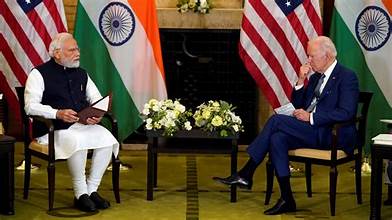India and the United States have finalized the terms for the initial phase of their bilateral trade agreement, which aims to significantly boost trade relations. The goal is to reach $500 billion in bilateral trade by 2030. While discussions continue, several critical issues remain at the forefront of the negotiations, particularly regarding tariffs on agricultural products.
Farm Goods Tariff Disputes: India’s Resistance to U.S. Demands
One of the most contentious issues in the ongoing trade talks between India and the U.S. is the matter of tariffs on farm goods. India is facing pressure from the U.S. to reduce tariffs on essential staples such as rice and wheat. However, India has indicated its reluctance to make significant cuts on these staples. Instead, the country is open to lowering tariffs on a range of other agricultural products, including almonds, cranberries, quinoa, oatmeal, pistachios, and walnuts.
Despite the ongoing negotiations, corn and soybeans are also expected to be key items in the discussions. The U.S. is keen to increase its exports of these agricultural commodities to India, as the country seeks to expand its access to the Indian market.
India’s Stance on Corn and Soybeans: Genetic Modification Concerns
India has a specific interest in corn due to its need to boost ethanol production. However, current Indian regulations prohibit the use of imported grains for ethanol production. Additionally, India does not allow the import of genetically modified (GM) food crops, while the U.S. primarily produces GM corn.
The United States is pushing India to allow the import of GM corn, arguing that ethanol made from this corn would be used only for blending with gasoline, and would not affect Indian agriculture. Furthermore, while India imports small quantities of non-GM soybeans, the U.S. is advocating for the lifting of restrictions on the import of American soybeans.
U.S. Focus on Animal Feed Exports to India
Another area of interest for the U.S. is the export of animal feed to India. As part of the trade negotiations, Washington is keen to establish greater access for its animal feed products in the Indian market, further boosting bilateral trade.
High Tariffs: A Major Point of Contention
The U.S. has expressed significant concerns over India’s high tariff rates on agricultural products. India’s average applied tariff rate stands at a substantial 39%, with specific tariffs reaching up to 45% on vegetable oils and around 50% on products like apples and corn.
Washington views these high tariffs as a substantial trade barrier, particularly for U.S. agricultural exports, including poultry, potatoes, citrus fruits, almonds, pecans, apples, grapes, and processed food items such as canned peaches, chocolate, cookies, and frozen French fries. In 2024, U.S. agricultural exports to India totaled nearly $2 billion, while India’s agricultural exports to the U.S. were valued at around $5.5 billion.
India’s Growing Food and Beverage Market
India’s food and beverage market, which is expanding at an annual rate of approximately 10%, is projected to reach $550 billion by 2028. This growth is attracting significant interest from U.S. companies seeking to tap into one of the world’s largest and fastest-growing markets for food and beverages.
Non-Tariff Barriers: U.S. Concerns on Import Restrictions
In addition to tariff barriers, the United States has raised concerns about India’s non-tariff barriers. These include quantitative restrictions on the import of protein-rich pulses, import license requirements, and stringent sanitary and phytosanitary regulations concerning food imports.
One major issue is India’s regulation on dairy imports. India imposes tariffs of up to 60% on some dairy products and mandates that imported dairy must come from animals not fed internal organs, blood meal, or similar byproducts. U.S. officials argue that this rule significantly restricts access to the Indian dairy market, one of the largest in the world.
Conclusion: Ongoing Trade Negotiations with Key Stakeholders
As India and the U.S. continue their trade talks, both sides are focused on resolving contentious issues related to agriculture, tariffs, and non-tariff barriers. While there is optimism about achieving a favorable outcome, the negotiations will likely require compromise on both sides to address these key points and pave the way for a robust bilateral trade relationship moving forward.







